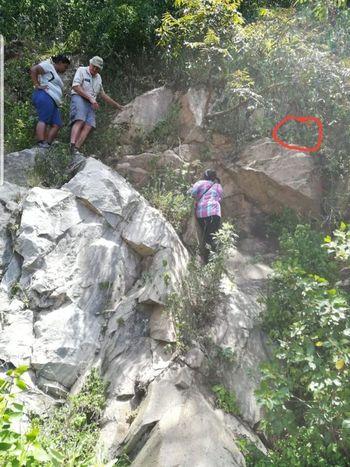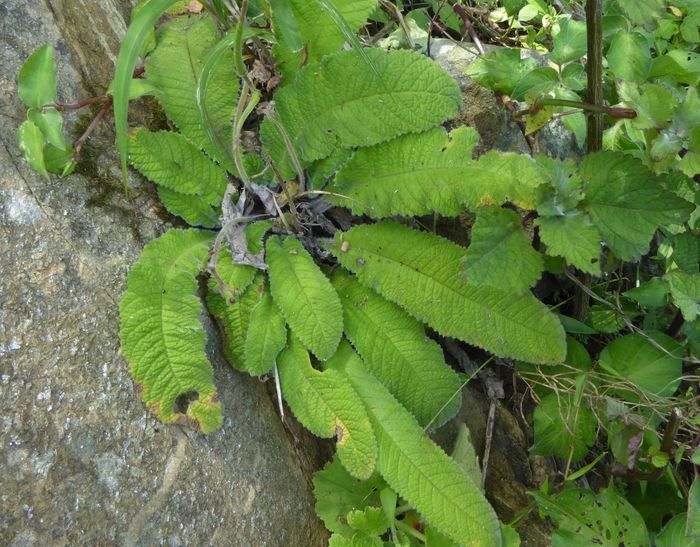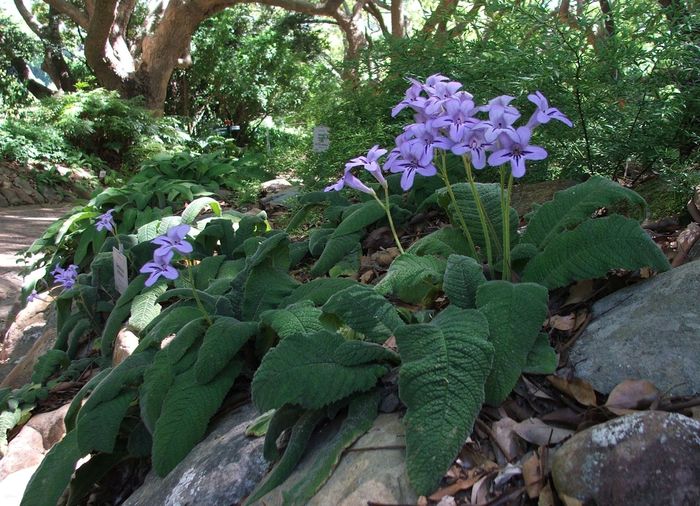Streptocarpus floribundus
Streptocarpus floribundus Weigend & T.J.Edwards
Family: Gesneriaceae
Common names: Kranskop streptocarpus, Kranskop Cape primrose
Introduction
Streptocarpus floribundus is a rare and threatened, vibrant gem, thriving in dense clusters among the doleritic outcrops of Kranskop, in KwaZulu-Natal. This free-flowering mauve beauty lives up to its scientific name, floribundus, which is Latin for ‘flowering freely’.

Description
Description
Streptocarpus floribundus is a perennial herb with leaves in a rosette at the base of the stem. The leaves are narrow and broaden near the apex. The leaf blades are between 250–500 mm long and 45–100 mm wide. The leaves are known to droop downwards and are covered with soft fine hairs. The margins are notched with rounded symmetrical teeth.

The inflorescence contains up to 20 flowers attached to the flower stalks, which are ± 250 mm long, glandular, with short thin hairs. The sepals are linear to narrowly egg-shaped, 3(−7) × 1 mm, hairy with reddish brown tips. The corolla is ± 60 mm long, cone-shaped, with the tube ± 50 mm long, and spout ±15 × 20 mm wide, white, with a yellow tinge on the interior near the base of the flower, glandular, with short thin hairs. Flowers are light mauve and lobed with distinct deep purple striations. Stamens are 10−20 mm long, containing light purple filaments and purple anthers that are ± 3.5 × 3.5 mm long. The ovary is about 15 mm long, with pressed dense hairs. Fruits are robust 90−110 × 2.5 mm. Streptocarpus floribundus flowers in early summer, between November and December.
Streptocarpus floribundus is similar to S. primulifolius and S. formosus in flower shape, colour and fruit. This species is distinguished by its deep violet stigma, fine glandular hairs on the peduncle and lower leaf blade, and its many-flowered inflorescences.
Conservation Status
Status
According to SANBI’s Red List of South African plants, Streptocarpus floribundus is assessed as Vulnerable (VU). Habitat degradation has been cited as a threat to this South African endemic. A recent search for Streptocarpus floribundus, by CREW citizen scientists proved to be successful with a population of about 50 plants being observed on an overlying doleritic outcrop. A specimen was collected by Suvarna Parbhoo in December of 2018 and is currently stored at SANBI’s KwaZulu-Natal Herbarium. This find demonstrates a more recent account of the population that was first collected by Olive Mary Hilliard in 1929.

Distribution and habitat
Distribution description
Historic records state that Streptocarpus floribundus is recognized only from the type locality discovered by Olive Mary Hilliard. This is reaffirmed by De Villiers (2008), who stated that Streptocarpus floribundus is confined to just one population known from its type locality in central KwaZulu-Natal. The species flourishes in shaded areas within Southern Mistbelt Forest vegetation in loamy soils at altitudes ranging from 700–900 m (Mucina & Rutherford 2006). The species thrives in clumps on forested doleritic cliff faces, cohabiting with Streptocarpus haygarthii.

Derivation of name and historical aspects
History
The genus Streptocarpus belongs to the same family as Saintpaulia (African violets), Gesneriaceae (Van der Walt 2001). This family was christened after Conrad Gesner (26 March 1516–13 December 1565), a Swiss naturalist who made significant contributions towards the description of floral and faunal species (Tarr 2008). The family comprises of about 2 900 species, in 130 genera globally (Tarr 2008).
The name of the genus Streptocarpus is derived from Greek origins, with streptos meaning ‘twisted’ and carpus meaning ‘fruit’ (Viljoen 2011), thus making reference to the twisted seed pods of this genus (Boodhraj 2018). Streptocarpus consists of more than 100 species, which have a distribution range from central Africa to Madagascar (Van der Walt 2001). A significant proportion of these species are known to occur in southern Africa. Many species occurring in this genus are favoured as pot plants and grown in gardens and glasshouses across the globe, including in the UK and in America (Van der Walt 2001). Within South Africa, there are about 51 naturally occurring species (Boodhraj 2018).

Streptocarpus floribundus in all its beauty was discovered by Olive Mary Hilliard in 1929. The species was originally documented as Streptocarpus primulifolius by Olive Mary Hilliard and Brian Laurence Burtt, as they assumed that the species exhibited traits similar to Streptocarpus cyaneus (De Villiers 2008). They put forth 2 theories, one suggesting that Streptocarpus floribundus was an ancestor of S. primulifolius and S. cyaneus and the other suggesting that Streptocarpus floribundus was a byproduct of cross breeding between the 2 species (De Villiers 2008).
Through DNA analysis, it was determined that Streptocarpus floribundus is one of the primary species in the Cape primrose clade (De Villiers 2008). De Villiers (2008) suggested that Streptocarpus floribundus may have evolved from S. cyaneus and is the element linking S. cyaneus to S. primulifolius. The evolutionary characteristics of S. floribundus are similar to S. primulifolius, although morphologically challenging to separate (De Villiers 2008).
Ecology
Ecology
Very little is known about the ecology of Streptocarpus floribundus, however, according to Harrison et al (1999), the genus Streptocarpus is pollinated by bees. Streptocarpus is a nectar-producing genus with attractively coloured flowers generating favourable scents to bees (Harrison et al 1999).
Uses
Use
There is no record of traditional, economic or medicinal uses for this particular species, however, the genus Streptocarpus is known to be utilized in traditional medicine, specifically in the Zulu culture, by pregnant woman to alleviate labour pains (Viljoen 2011). According to Nishii et al (2015) approximately $30 million has been earned through the international trade of Streptocarpus species for horticultural and decorative purposes.

Growing Streptocarpus floribundus
Grow
Like most species in the Gesneriaceae family, the Streptocarpus genus is an attractive plant for potting. The genus is relatively resilient when compared to other genera within Gesneriaceae and may be an ideal potting plant. The genus is characterized by brightly coloured flowers with uniquely textured leaf structures, that are sometimes covered in hairs, with some species being unifoliate, whereas others are rosulate.
There is limited information on the cultivation of Streptocarpus floribundus, however, UKZN-based horticulturist, Alison Young is currently attempting to propagate this vulnerable species from a specimen collected at the type locality. The species prefers to grow in cool, moist and shaded doleritic cliff faces, in well-drained, dark loamy soils. It is significant to note that these plants are not a fan of direct sunlight and will most likely burn in unfavourable temperatures. According to Alison Young, leaf miner caterpillars have been identified to hide on the underside of the leaves and get into the flowers. These pests chew on the flowers and can hinder the growth of the plant.
The suggestions made in this publication are based on the broad cultivation of the Streptocarpus genus, rather than specifics related to Streptocarpus floribundus.
The seeds of these plants can be germinated by keeping the seeds in a damp cool area covered in a soilless medium (Boodhraj 2018). Shoots can be observed after a few weeks, during which time, the seedlings can be transplanted into potting soil for optimum growth (Boodhraj 2018).
It is important to be cautious when watering the plants, as excessive watering will jeopardize the development of the species and will result in the formation of mould and rotting of the plant (Baley 2018). Drainage is, therefore, another factor to consider when propagating Streptocarpus species, as a well-drained medium will produce the best growth results (Baley 2018).
It is possible to grow species of Streptocarpus from its leaves (Baley 2018). This is achieved by slicing off the central vein of the leaf, thus separating the leaf into 2 halves (Baley 2018). Place these 2 halves in potting soil with the exposed side (cut part) of the leaf towards the soil (Baley 2018). These halves need to be kept damp, but not overly saturated in water, until the formation of shoots can be observed (Baley 2018). Subsequently, new juvenile plants can be observed after a couple of weeks, forming along the cut parts of the leaves (Baley 2018). Once noticeable growth is observed in the juveniles, they can then be detached from the ‘mother leaf’’ and replanted, in order to flourish as individual plants (Baley 2018).
References
- Baley, A. 2018. Streptocarpus Information: how to care for Streptocarpus houseplants. https://www.gardeningknowhow.com/houseplants/Streptocarpus-plants/care-for-Streptocarpus.htm, accessed on 10 May, 2019.
- Boodhraj, R. 2018. Streptocarpus confusus Hilliard. (Gesneriaceae). PlantZAfrica. Online. http://pza.sanbi.org/Streptocarpus-confusus.
- De Villiers, M.J. 2008. Phylogenetic and population genetic studies in the genus Streptocarpus Lindl.(Gesneriaceae DC.). Doctoral dissertation, Stellenbosch University, Stellenbosch.
- Harrison, C.J., Möller, M. & Cronk, Q.C. 1999. Evolution and development of floral diversity in Streptocarpus and Saintpaulia. Annals of Botany, 84(1): 49–60.
- Johnson, I.M., Bellstedt, D.U. & Von Staden, L. 2011. Streptocarpus floribundus Weigend & T.J.Edwards. National Assessment: Red List of South African plants version 2017.1. Accessed on 2019/05/06.
- Mucina, L. & Rutherford, M.C. (eds) 2006. The vegetation of South Africa, Lesotho and Swaziland. Strelitzia 19. South African National Biodiversity Institute, Pretoria.
- Nishii, K., Hughes, M., Briggs, M., Haston, E., Christie, F., De Villiers, M.J., Hanekom, T, Roos, W.G., Bellstedt, D.U. & Moller, M. 2015. Streptocarpus redefined to include all Afro-Malagasy Gesneriaceae. Taxon 64 (6): 1243–1274.
- Pooley, E. 1998. A field guide to wild flowers Kwazulu-Natal and the eastern region. Natal Flora Publications Trust, Durban.
- Tarr, B. 2008. Streptocarpus cooksonii B.L.Burtt. (Gesneriaceae). PlantZAfrica. Online. http://pza.sanbi.org/Streptocarpus -cooksonii
- Van der Walt, L. 2001. Streptocarpus formosus Hilliard and Burt. (Gesneriaceae). PlantZAfrica. Online. http://pza.sanbi.org/Streptocarpus-formosus
- Viljoen, C. 2015. Streptocarpus primulifolius. (Gesneriaceae). PlantZAfrica. Online. http://pza.sanbi.org/streptocarpus-primulifolius
- Viljoen, C. 2011. Streptocarpus gardenii Hook. (Gesneriaceae). PlantZAfrica. Online. http://pza.sanbi.org/Streptocarpus-gardenii.
- Weigend M. & Edwards T.J. 1994. Notes on Streptocarpus primulifolius (Gesneriaceae). South African Journal of Botany 60 (3):168, 169.
Credits
Kaveesha Naicker
Custodians for Rare and Endangered Wildflowers (CREW) – Summer Rainfall Region
September 2019
Plant Attributes:
Plant Type: Perennial
SA Distribution: KwaZulu-Natal
Soil type: Sandy, Loam
Flowering season: Early Summer
PH:
Flower colour: Purple, Mauve/Lilac
Aspect: Shade, Morning Sun (Semi Shade)
Gardening skill: Average
Special Features:
Horticultural zones









Rate this article
Article well written and informative
Rate this plant
Is this an interesting plant?
Login to add your Comment
Back to topNot registered yet? Click here to register.